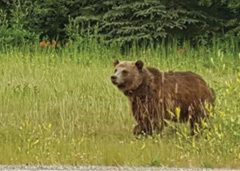In more than 1,000 quarries and pits worldwide, HeidelbergCement is committed to managing biodiversity during and after extraction by promoting a high diversity of local flora and fauna.
The Quarry Life Award is a scientific and education contest by HeidelbergCement. The competition takes place every two years and runs simultaneously at national and international levels. Its aim is to raise the awareness of the organic value of mining sites and to find new ways to further enhance it.
The company announced the winners of the 2018 Quarry Life Award for North America.
1st Place: The Co-Existence of a Threatened Population of Grizzly Bears with Quarry Mining in Alberta, Canada (Cadomin Quarry).
2nd Place: Ruling The Roost: Developing Thermally Optimal Roosts to Enhance Microbat Population Biodiversity (Cadomin Quarry).
Lehigh Hanson’s New Windsor Quarry in Maryland also participated in the award program. Initial proposals were submitted by contestants in November of last year.
A panel of judges consisting of Patrick James, Tom Chizmadia, Sophie Mullen and Tim Matz from Lehigh Hanson along with Dr. Sue Grayston, a professor from the University of British Columbia, and Margaret O’Gorman, president of the Wildlife Habitat Council, selected the winning proposals.
“On behalf of Lehigh Hanson and HeidelbergCement, I would like to congratulate the winners of the 2018 Quarry Life Award program for North America,” said Tom Chizmadia, senior vice president of government affairs and communications. “The winning proposals clearly demonstrate the spirit of the program and its emphasis on managing biodiversity at our quarry sites. It was a pleasure working with this year’s participants.”
The Cadomin limestone quarry is located in the town of Cadomin, Alberta, Canada, which is about 360 km west of Edmonton and 50 km south of Hinton. The quarry is a 181-hectacre site located in the foothills of the Rocky Mountains and is contained by the McLeod River to the west, foothills with subalpine vegetation to the north, and a Zone 1 Prime Protection Area to the east. Other major industrial operations in the area include forestry and coal mining; with several abandoned mines and towns located nearby.

The quarry supplies close to one million tons of limestone to Lehigh Hanson’s Cement Plant in Edmonton by rail for production of cement. The mine is not a typical pit run mine. Instead, material is blasted off the working face and deposited into a 50 meter raise (material chute) where it is crushed and stored completely inside the mountain; only when it’s transported to Edmonton via rail does the rock leave the inside of the mountain.
Located in the foothills and montane regions, the area provides habitat for a diverse range of species. Some of the recognized species in the region include Black Bears, Grizzly Bears, Cougars, Big Horn Sheep, White Tailed and Mule Deer, Whitefish, Harlequin Ducks and several species of bats.
Grizzly bears frequent the quarry lands and adjacent properties which is why Lehigh has previously worked with the Foothills Model Forest to research grizzly migrations through the area. Lehigh has also worked with Trout Unlimited to re-armor banks along the McLeod River to sustain and improve fish spawning habitat.
One of the main ecological concerns in Cadomin is the bat population. Across from the quarry exists the “Cadomin Caves,” a large maze of caves that are still not yet fully surveyed, but are known to be of significant importance to hibernating bat populations that make use of the habitat

